Patterns view
Patterns view is an area, which allows you to manage the saved regex patterns.
How does it look like?
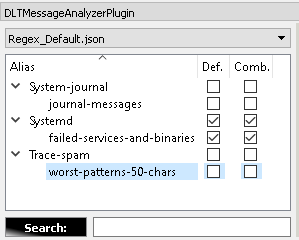
Pattern naming convention
Each tree level is formed via the “_” delimiter in the pattern name.
For example the following regex name:
Module_Executable_Domain_Regex-1
will form the following representation:
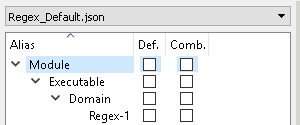
All saved patterns are represented as a tree-view.
Saving the new regex patterns
To save a new element you can do the following.
Enter any useful regex expression into the “regex input” edit field:

Then, do a right-click to visualize the context menu, and select the “Save …” option:
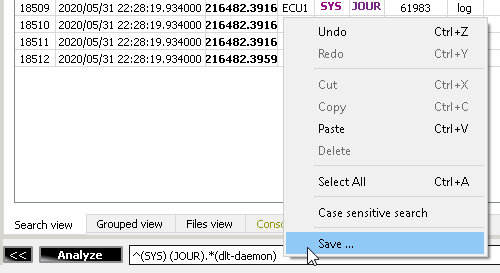
Fill in the alias name. Depending on which element was the already selected one in the “Patterns view” the plugin might auto-fill part of the alias name, to locate a new pattern in the same sub-tree. After that press OK:
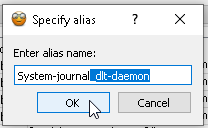
Check the result in the “Patterns view”:
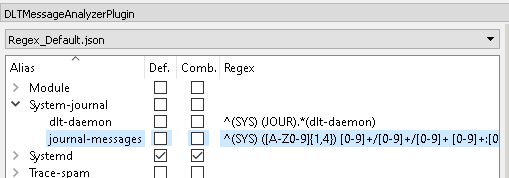
Note!
The easiest way to use the newly saved regex pattern is to double-click on it. That will cause a search with the usage of a stand-alone regex pattern.
Relocation of the sub-tree levels
The plugin allows you to move a particular sub-tree into another location.
Just select any non-leaf element:
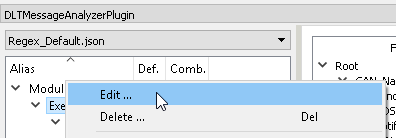
Adjust its location, via e.g.:
- Addition of new sub-tree levels
- Removal of existing sub-tree levels
- Specifying the totally new location


Press OK:

Check the modified tree:

Note!
It is possible to move one sub-tree level into another one. In such a case plugin’s implementation will merge both sub-trees. In case if 2 sub-trees will have collisions of leaf elements, the plugin will ask you regarding whether you want to overwrite the existing pattern with the candidate one. The prompt will be provided for each collision.
Editing the existing elements
You can edit already existing patterns.
Just select any target leaf element:
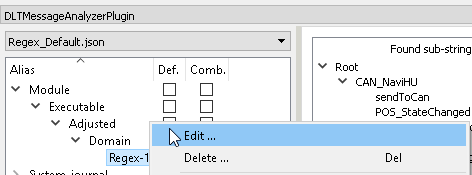
Adjust its location, via e.g.:
- Addition of new sub-tree levels
- Removal of existing sub-tree levels
- Specifying the totally new location
- Changing the regex name
Adjust the target regex.
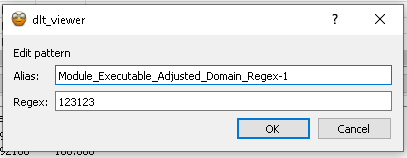
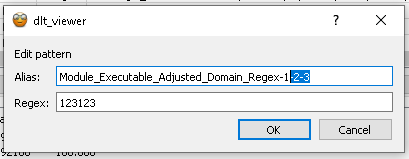
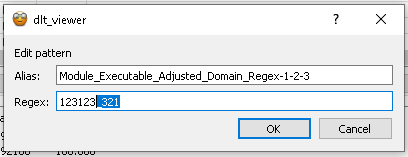
Press OK:
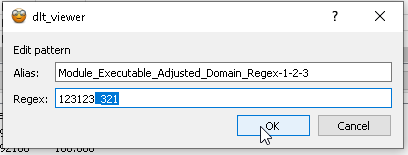
Check the modified tree:
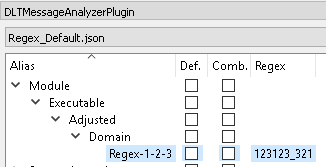
Def. & Comb. options
Each saved regex pattern within the plugin as of now has 4 parameters, 3 of which are persisted:
- Regex alias - persisted
- Regex expression - persisted
- Default - persisted
- Combination - on start-up equal to the default parameter. In-RAM parameter only. Not persisted
The purpose of “default” and “combination” settings is to allow you to form more complex regex expressions from a set of the saved ones.
Some examples from the real project: you want to see “FPS of your app” & “CPU consumption of cgroups” & “Top 10 threads within the system” & “List of crashed systemd services”. Combination of 4 regex patterns would easily allow forming such a request to analyze performance issues.
As I can’t provide here examples from the real project, here is another “simplification with screenshots”.
I’ve created 2 patterns:
- One gets system journal messages of dlt-daemon
- Another one gets the “logger_test” message from the system journal and marks it as an error.
I’ve checked the “comb.” setting of both patterns:

Now I’ve pressed “Enter” to apply the combination. Result regex will consist of regexes of both parts of combination, concatenated with “pipe” OR operator:

The search result will consider both parts of the request and will contain the following messages:

As you might assume, the “Def.” option means the same as “Comb.”, besides the fact that it gets persisted into the JSON configuration. So on next each LC of the dlt-viewer, the plugin will return to the set of “Def.” patterns. You can think of it as of some sort of favorites option.
Another bonuses, which come with this functionality, are the ability to:
- Instantly switch from any Comb. selection back to a set of “Def.” favorites
- Clear the “Comb.” selection to create some specific combination

Note!
Above example is a simplification. But in case, if you have 100+ saved patterns, then those options will allow you to feel the power of deep analysis at your fingertips.
Patterns search
“Pattern view” functionality allows you to search specific regex expressions by their aliases. Simply use the “Search” input field to narrow down the number of the shown regex patterns. The regex expressions are used to implement the search, so you can combine multiple names with ”|” operator:
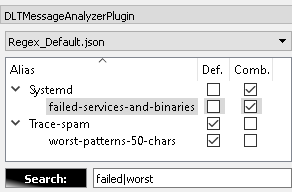
Also, there is a possibility to filter only comb or def patterns and hide all the others.
Type in “%def” to see ONLY “Def.” patterns:
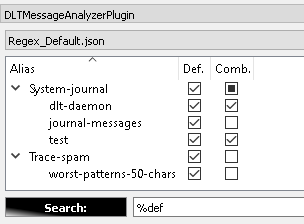
Type in “%comb” to see ONLY “Comb.” patterns:
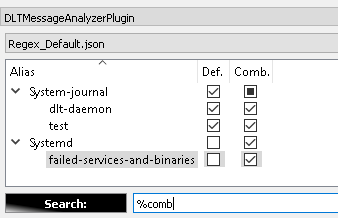
Usage of multiple regex configuration files
Let’s imagine, that 2 developers are working in the different teams and different domains of the same project. And, for some specific case, one needs to get the “analysis domain knowledge” of the other to analyze a specific rare top issue. Usually, such attempts end up with endless time-consuming ping-pong communications and meetings between the domains.
The plugin allows shortening the time of knowledge transfer, as it allows you to work with multiple regex configuration files. That means, that, if each domain is forming their “analysis knowledge” in form of the regex patterns within the plugin, the sharing becomes as trivial as sending the regex configuration file to the colleague.
The following option in the context menu of the “Patterns view” will allow you to open the location of the regex storage of the plugin within your filesystem explorer:
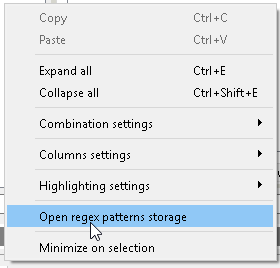
The opened file-system path would look something like this:

You can use that to add someone’s configuration file or to get yours. The plugin’s implementation continuously monitors the context of the folder. As soon as it gets a notification about the file-system update, it will update its own “available regex configurations” combo-box:

As soon as you will select the alternative regex configuration, the view will be updated with the new patterns:
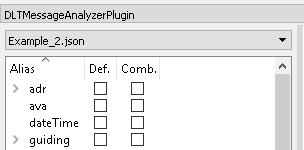
Note!
Plugin supports copy-paste of patterns between the files via the Ctrl+C and Ctrl+V shortcuts ( or via the corresponding context-menu items ). It might become quite useful, in case if you’ll decide to use some of the colleague’s regexes in combination with your ones.
Currently, it works ONLY within an instance of the dlt-viewer. Sharing between the multiple instances is not supported.